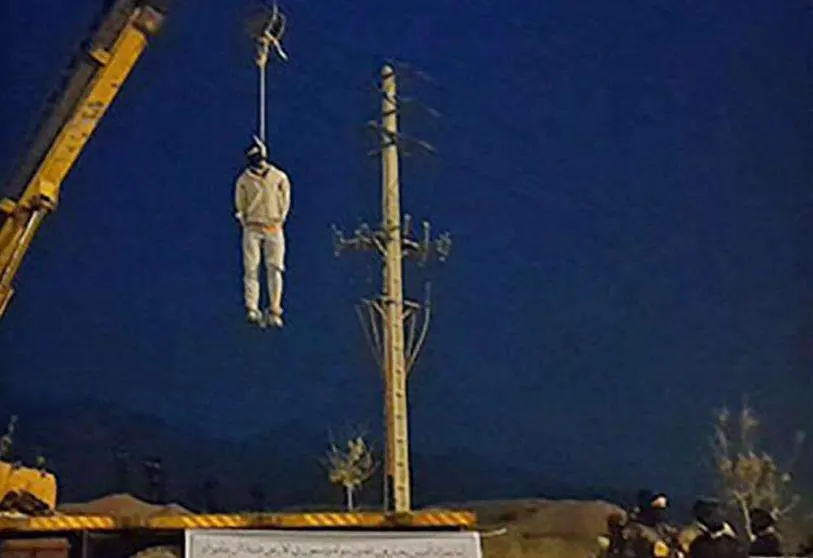"No to execution!" A plea against the main political and religious tool of Iran's medieval regime

The decision to execute Mohsen Shekari and Majid-Reza Rahnavard cannot have any legal basis. At least not as it is conceived in the West. In fact, a decision was taken in a political, security and intelligence committee of the mullahs' administration under the assumed leadership of Supreme Leader Ali Khamenei, who ordered these executions only for political purposes and not to deliver justice. In this sense, one need only look at the 44-year history of the Islamic Republic to be convinced that the death penalty in Iran is a repressive weapon, wielded in an arsenal that serves only terror to keep power in place.
If the phenomenon is well known, this time the hasty decision to punish two young demonstrators for having dared to defy religious authority has provoked reactions contrary to those expected in the circles of power. Thus, Mohammad Sarafraz, former director of state radio and television, declared that "the government has reached a state of misery and is unable to respond to the slightest demand of the population. Killing people is not sustainable". This is not an isolated public statement, as Mustafa Moin, former Minister of Science, agrees: "The execution of Mohsen Shekari has become the starting point for new scandals in Iran and the world".
It must be said that the effects of the popular uprising for justice and freedom are being felt at the highest levels of the regime. With each passing week, Ali Khamenei's extreme, hardline stance is losing him allies and leading inexorably to his downfall. Against a backdrop of already weakened power, the executions of Mohsen Shekari and Majid-Reza Rahnavard can only lead to renewed vigour in the protesters' camp and greater defiance from the mullahs ousted from power. However, for more than 5,000 years, human history is replete with examples of leaders overthrown by their respective peoples for having locked themselves into an overly authoritarian position. In trying to erase the past in order to build a new era, we forget the lessons of historical wisdom...
Over the past 44 years, execution figures show that the Velayat-e-Faqih regime1 holds the world record for executions (per capita). Ultimately, execution is nothing more than a tool wrapped in a religious disguise to perpetuate the regime's omnipotence. Jurisdiction, all laws and all punishments are interpreted in the service of this single objective. Thus, the razor of repression is further sharpened to better foment terror. In fact, the mission of the judiciary in the Islamic Republic has always been to propagate this terror in the service of religious theocratic power.
To be convinced of this, one only has to look at the space left for independent bodies, defence lawyers, juries.... Nothing is provided for them in the Constitution of the Islamic Republic. There is nothing in the Constitution of the Islamic Republic that can hinder the progress of the fear of these men who are supposed to represent the divine. For 44 years, hanging has been the mainstay of a tyrannical regime.
The 90-day continuation of a nationwide uprising in Iran, whose only demand is the overthrow of the death penalty regime, has plunged the country's religious authorities into a bottomless pit. A hole from which Ebrahim Raissi's government thought it could escape by digging even deeper. The execution of the two young protesters seemed the only solution to the political and social impasse. Cornered, but fiercely clinging to its privileges and dogmas, the regime had no choice but to resort to the most "anti-human" crimes, and in public.
In short, the hanging of Mohsen Shekari and Majid-Reza Rahnavard is an act of revenge by the authorities against the Iranian people, whose only crime is to have paralysed the country for more than three months. Once again, after 44 years of bloody experiences, it has been shown that the only way to confront the medieval rule of the mullahs is through steadfast determination. In this regard, one protester described his experiences of the last three months on social media with these words: "You (the regime) did not accept a protest with words, poetry, writings, art, slogans or rallies. Nor will you accept it with demonstrations or by shouting at night from the rooftops of houses".
A few days ago, professional footballer Amir Nasr-Azadani was also arrested for demonstrating against the regime. After being imprisoned, he was found guilty of "armed rebellion against the Islamic State or the Republic". A charge punishable by the death penalty. Will the Supreme Leader continue to lock himself in his mortifying logic, delving ever deeper into hatred and rancour, by displaying the lifeless body of Amir Nasr-Azadani, hanging by his neck from the top of a crane, in the populous suburbs of Tehran?
For 90 days, the national uprising has driven an irreparable wedge between the people and the government. This revolution of a sovereign people has revealed more than ever that the rejection of execution means the denial of the integrity of the Iranian regime. So let the cry of "No to execution!" against the main political and religious tool of the medieval Iranian regime resound throughout the world.

